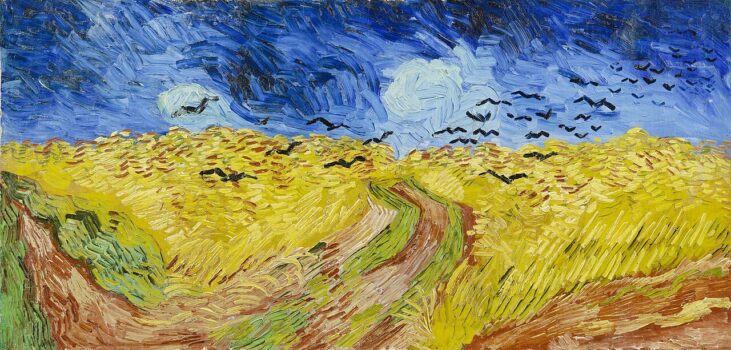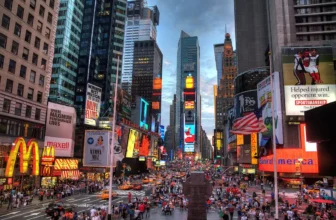Wheat Field with Crows by Vincent van Gogh
In the summer of 1890, in the final, fevered weeks of his life, Vincent van Gogh painted one of his most haunting and powerful masterpieces: Wheat Field with Crows. With its turbulent sky, slashing brushstrokes, and ominous black birds slicing through the air, this painting continues to evoke strong emotions and provoke deep interpretation. It is not only a landscape, it is a psychological self-portrait, a meditation on mortality, and perhaps, a visual suicide note.
This story dives into the complex layers of Wheat Field with Crows, unraveling its symbolism, exploring what may have been happening in Van Gogh’s mind, and reflecting on how this painting became one of the most poignant artifacts in art history.
What is Happening in Wheat Field with Crows?
At first glance, Wheat Field with Crows is a relatively simple composition. The canvas is divided into three main sections: a golden wheat field below, a deep blue sky above, and a central path that cuts straight into the distance, vanishing into the horizon, or disappearing altogether. The path appears to split into three directions, suggesting ambiguity or indecision.
Above the field, a murder of crows is frozen mid-flight. They surge toward or away from the viewer, their presence abrupt and unsettling. The sky, though blue, is not serene. It is heavy, almost bruised, churned by deep, emotional brushstrokes that convey a sense of impending storm or turmoil.
There are no human figures, no shepherds, no distant cottages, only the wild, the windswept, and the uncaged. And yet, the absence of humanity makes the painting feel even more personal. It’s as though the viewer is alone, standing where Van Gogh once stood, peering into a landscape filled with both beauty and despair.
The Context: Painted at the Edge of Life
Vincent van Gogh painted Wheat Field with Crows in July 1890, during his stay in Auvers-sur-Oise, a small village north of Paris. He had moved there to be closer to his brother Theo and had been under the care of Dr. Paul Gachet, who believed art could be therapeutic.
Despite a brief period of prolific creation, he painted more than 70 works in 70 days, Van Gogh’s mental health was unstable. He had long battled depression, anxiety, and episodes of psychosis. In one of his final letters to Theo, he expressed a sense of being “in a mood of almost too much calm,” which he feared might break.
Just days after finishing Wheat Field with Crows, Vincent walked into one of the fields he so often painted and shot himself in the chest. He died two days later, on July 29, 1890. The painting is widely believed to be one of his last, if not the very last, works he ever completed.
Symbolism and Interpretation: What Does It All Mean?
1. The Crows: Harbingers of Death or Symbols of Freedom?
The black crows dominate the upper third of the painting. In art and literature, crows often symbolize death, foreboding, or the soul’s departure. Many interpret these birds as omens of Van Gogh’s impending suicide, a sky full of messengers that hover above the end of all things.
However, others see them differently. Crows are also clever, communal, and resilient creatures. They can symbolize transformation, mystery, or even freedom. Could they be rising out of the wheat field, escaping the earth, carrying Van Gogh’s spirit skyward? Or are they descending, invading the golden fields with darkness?
Van Gogh himself wrote in earlier letters about including crows in wheat fields to suggest “sadness” or “loneliness,” yet he never specified their meaning in this particular painting. Their ambiguity makes them powerful. They are both literal and metaphorical, real and spectral.
2. The Path: Divergence, Decision, or the Journey’s End?
The central path in the painting is jarring. It abruptly forks, becoming three, then none. It invites the viewer in, but it leads nowhere. It’s not a path that promises direction, it is the embodiment of uncertainty.
This could be interpreted as a metaphor for Van Gogh’s life at that moment. Was he contemplating different paths, trying to choose among them, only to find that each one ended in the same conclusion? Or was it a representation of his psychological confusion and the impossibility of escape?
The road is also a classic symbol in Van Gogh’s work, he painted numerous paths through wheat fields, gardens, and forests, often as metaphors for life’s journey. But this one, unlike the others, seems cut off, swallowed by the chaos around it.
3. The Wheat Field: Life and Nature’s Eternal Cycle
Wheat, for Van Gogh, was a recurring motif. It symbolized both nourishment and the cycle of life and death. He was deeply inspired by the idea of the seed buried in the earth, growing toward the sun, only to be harvested and returned to the soil.
The wheat field in this painting is wild and unkempt. It lacks the order or calm of his earlier depictions. The brushstrokes are thick, impassioned, and frantic, as though Van Gogh painted not with brushes, but with his very breath.
This field is not a place of harvest, it is a place of confrontation. Life has grown to its fullest and is now teetering toward decay. The golden color, though bright, feels claustrophobic, closing in on the viewer as the sky presses down from above.
4. The Sky: Emotion Made Visible
Perhaps the most overwhelming element of the painting is the sky itself. Painted in swirling, uneven strokes of deep ultramarine and cobalt, it seems alive with emotion. Unlike the tranquil skies of Starry Night, this one feels tortured.
The sky doesn’t merely set the background, it speaks. It reflects Van Gogh’s internal state: the weight of his depression, the struggle for light amidst darkness, the storm that never breaks but always threatens.
This is not a passive sky. It is an active participant in the drama, enveloping the field below and the viewer standing before it.
Van Gogh’s Intent: Was This a Goodbye?
Many have argued that Wheat Field with Crows was Van Gogh’s final farewell to the world, a symbolic suicide note written in color and form. However, this interpretation, while emotionally compelling, may oversimplify his intent.
In truth, Van Gogh never explicitly mentioned this painting in his letters. Nor did he suggest he was planning to take his life. His final artworks are diverse and include bright, joyful gardens and peaceful village scenes. He was both productive and prolific in his last days, which complicates the narrative of hopelessness.
Still, the painting feels too raw, too emotionally charged, to be a mere landscape. Whether he meant it as a final statement or not, it is impossible to view it without sensing the tension between life and death, beauty and despair, peace and agony.
Where is Wheat Field with Crows painting Today?
Today, Wheat Field with Crows resides in the Van Gogh Museum in Amsterdam, the Netherlands. It is part of their permanent collection and is one of the most visited and revered paintings in the entire museum.
Standing before it in person is a deeply affecting experience. The colors, more vivid than reproductions can capture, leap from the canvas. The scale of the painting (50.5 × 103 cm or 20 × 40.5 inches) is modest, yet it commands the room. It pulls viewers into its haunted landscape, confronting them with Van Gogh’s final brushstrokes.
The painting is often surrounded by viewers who stand silently, absorbing its power. For many, it is not just a work of art, it is an emotional encounter with a man who suffered greatly, saw deeply, and painted furiously.
A Field of Feeling
Wheat Field with Crows is one of the most powerful visual testaments to the complexity of human emotion ever created. It is neither wholly bleak nor purely hopeful, it contains both. That duality is what makes it timeless.
Van Gogh once said, “I put my heart and my soul into my work, and have lost my mind in the process.” This painting proves the truth of that statement. It is a cry, a confession, a landscape, and a legacy. In its swirling skies and sun-bleached wheat, we see not only the world through Van Gogh’s eyes, but perhaps also our own mortality.
It reminds us that beauty and pain can coexist, that nature can mirror the soul, and that even in the darkest moment, art can illuminate the human condition with startling, unforgettable clarity.
Fun Fact: The exact sequence of Van Gogh’s final paintings is still debated by art historians. While Wheat Field with Crows is often cited as his last work, some evidence suggests Tree Roots may have been painted after it. Regardless, Wheat Field with Crows remains the more emotionally resonant and widely regarded farewell painting.
If you ever find yourself in Amsterdam, don’t miss the chance to stand in front of it. You’ll be standing at the edge of a field, between light and shadow, past and future, despair and expression, and hearing the crows for yourself.




